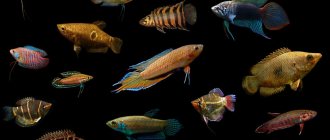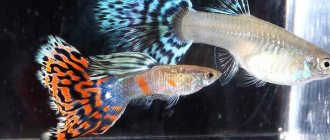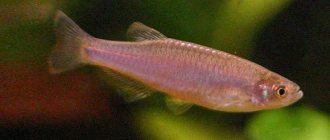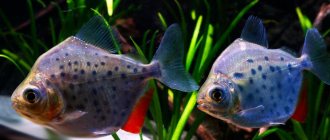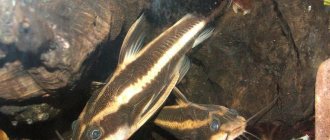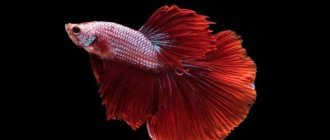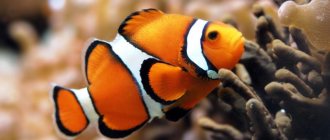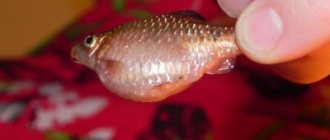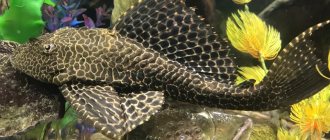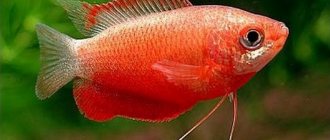Black swordtail
The variety of aquarium fish is sometimes amazing. And taking into account the fact that one type of fish has its own varieties, the aquarium world becomes simply gigantic.
swordtails , even those who have never even seen aquariums. We can say that swordtails, the fish of all children of the Soviet Union, were in all Soviet aquariums. The fish is very beautiful and unpretentious.
Such popularity has led to the fact that swordtails have undergone serious breeding work aimed at obtaining various color morphs through hybridization. Morphs, in turn, actually drove all natural swordtail species out of the market.
Compatibility of Swordtails
Swordtails are non-aggressive. They are compatible with almost all small peaceful fish. Among the best neighbors are tetras , minors , thornets , zebrafish , all poeciliid fish , etc. They are compatible with almost all bottom fish: corydoras , acanthophthalmus , platidoras , ancistrus , etc. They get along well with “peaceful” cichlids, for example, with angelfish .
Black swordtail photo
Swordtails are incompatible with aggressive and large fish that will hunt them, for example, cichlids (acaras, astronotuses, diamond cichlids, etc.). In addition, it is not recommended to add them to “veiled” fish, because the latter are slow and swordtails can “pinch” them by their fluttering fins.
Male swordtails show some intolerance and aggression towards each other. There have been cases of males fighting, even to the point of causing damage to each other. Therefore, in an aquarium, swordtails should be kept in a harem, so that there are 2-3 females per male. In this case, the intraspecific aggressiveness of the fish is noticeably reduced. See the article on aquarium fish compatibility.
General information
The black swordtail, officially Xiphophorus hellerii var Black, is a breeding form of the green Heller's swordtail. The name speaks for itself - the color of the fish is black. If you provide certain lighting, you can see blue-green reflections on the body. The scales also have an interesting tint, which can shimmer with a silver or orange tint.
It is impossible to find it in the wild, since this hybrid appeared as a result of long breeding work by crossing the green swordtail and multi-colored platie.
Black swordtails are very similar in appearance, size and body shape to other representatives of the species. But it is their color that distinguishes them. With the correct selection of lighting for the aquarium, you can observe the unusual, multi-colored shimmer of the scales of the swordfish.
Minimum aquarium volume for swordtails
Many novice aquarists keep swordtails in small aquariums. However, this is not entirely correct. In fact, swordtails are quite large fish. And taking into account the fact that it is recommended to keep swordtails in the proportion of 1 male to 2-3 or more females, the minimum size of the aquarium for them should be from 50 liters per harem family. The aquarium for swordtails should be spacious, it is better to take 100 liters.
Find out how many fish you can keep in X liters of aquarium HERE (at the bottom of the article there are links to aquariums of all sizes).
Price
Swordtails can be purchased in pet stores in a variety of colors and fin shapes. The most popular remains the red swordtail. This is a classic of the aquarium genre. For such a fish, sellers of branded pet stores ask from 50 to 100 rubles. This is the price of a swordtail that has already grown up.
In simpler trade enterprises or from private individuals, the price of swordtails starts at 10 rubles. It is possible to receive swordtails as a gift. These fish reproduce quickly and fill the aquarium spaces. A caring owner periodically faces the task of transferring excessively proliferating swordtails to other hands.
Care requirements and conditions for keeping swordtails
Swordtails do not need any special conditions. In fact, maintaining optimal aquarium water parameters is the key to their well-being. However, do not forget that:
1. Swordtails definitely need aeration and filtration, weekly replacement of up to 1/4 of the volume of aquarium water. It is worth noting that these fish do not need a lot of oxygen, and too frequent changes (replacement) of aquarium water are not as beneficial for them as for other types of aquarium fish. Therefore, if you change the water less often, for example, once every 14 days, and not every 7, nothing bad will happen. This rule is appropriate with a stable biobalance and zero nitrogen: NH4, NO2, NO3. As with any other fish, high concentrations of poisons are unacceptable: ammonia, nitrites and nitrates . Every conscientious aquarist should always have a set of drop tests on hand, at least for nitrate and phosphate. Fortunately, they have now become inexpensive, there are no problems with their assortment and acquisition. For example, we can with a clear conscience recommend you the cool UHE drop tests, , but they are sold only online. In stores in your city - offline, you can find inexpensive Vladox tests . Friends, watch out for nitrogen compounds, keep them in check and everything will be fine for you and your pets.
It would be useful to use clean water supply for deep water changes and use preparations that neutralize harmful substances. For example, Tetra AquaSafe - it removes chlorine compounds, heavy metals + contains B vitamins, iodine and other aquarium goodies.
Black swordtail photo
2. The aquarium must be covered with a lid, because The fish are nimble and can jump out and die.
3. Like many fish, swordtails feel comfortable among vegetation. Vallisneria , Echinodorus , Cryptocoryne , Riccia , duckweed as aquarium plants for them . Creating thickets of plants imitates the natural habitat of fish.
4. When decorating an aquarium, it is necessary to organize an open space for swimming. Swordtails are excellent swimmers. Swordtails do not need shelter at all.
Round-headed swordtail
It is distinguished by a high rounded forehead and a large dorsal fin, similar to a fan. Males do not have a sword at all, or instead have a tiny appendage. The size of the fish is 5-7 cm.
Also a natural variety that came to us from tropical rivers. The color of the scales is silver with a pinkish tint, and there are transverse gray stripes along the body. The dorsal fin of females is gray with dark speckles, while that of males is bright yellow. The remaining fins and tail are colorless.
The requirements for maintenance and feeding are the same as for the Alvarez swordtail, the only peculiarity of the species is that there should be at least twice as many girls as boys.
Feeding and diet of swordtails
Swordtails are unpretentious in food, they are omnivores and prone to overeating. They enjoy eating dry and freeze-dried food: flakes, granules, chips. You can easily use Tetramine as a base feed. And additionally feed containing carotenoids.
Allow me to make a small note. Color series food - enhances the natural color of fish (red, yellow colors), as it is enriched with pigments such as canthaxanthin, astaxanthin . In fact, carotenoids are natural “coloring” substances. It is astaxanthin that gives plants their red-orange color, carrots are a prime example of this. Or, for example, have you ever wondered why flamingos are pink? Yes, that's exactly why. By eating plant and animal foods rich in carotenoids, the flamingo's plumage, which is initially white, gradually turns pink. The more birds receive this substance from food, the richer and redder the plumage becomes. If you look even deeper, flamingos eat the well-known brine shrimp - pink, saltwater crustaceans and also turn pink.
Actually, the same thing happens to fish if the food contains carotenoids. We also note that astaxanthin also has other beneficial properties - it is also an antioxidant. In general, we can say that carotenoids are beneficial not only for fish, but also for all aquatic organisms, even aquarium plants. The only thing is that everything should be in moderation and balanced. You need to understand that the color of the fish also depends on the state of health, environment, life circumstances (stress/spawning) and the characteristics of the aquarium lighting.
Actually, to summarize, the Color series food is good, but should not be a basic diet. Imagine what will happen to a person who eats only one beet all week =) It’s scary to imagine. The same goes for the fish... sorry, they start pooping cute pink poop.
In this matter, by the way, it is very important not to overfeed the fish, so as not to run into problems with the gastrointestinal tract. Feed the swords once a day, do fasting days. This will be one of the keys to success in their maintenance. It should be noted that when purchasing any dry food, you should pay attention to the date of its manufacture and shelf life, try not to buy food in bulk, and also store the food in a closed state - this will help to avoid the development of pathogenic flora in it.
Description
Swordtails belong to the family of viviparous toothed carps. The body is elongated, flattened laterally.
The natural background color of males is light brownish-olive, with a green tint on the back. A two-millimeter red stripe runs along the sides, and below and above it there are two more narrow red stripes. The long lower ray of the caudal fin (sword) has a clear black edge. The color of the female is much paler, the body has a silvery sheen, the middle of the body is occupied by a wide stripe, and below and above this stripe there are two more narrow stripes 0.5 mm wide.
As a result of selection, swordtails have not only a variety of fin shapes, but also different body colors: black, red, olive, orange, yellow and combinations thereof (for example, a yellow body and black fins). Swordtails have also been bred with two swords - at the bottom and the top of the tail.
The male's body (without the sword) can grow up to 8 cm, and the female's body up to 12 cm.
Swordtails live up to three to five years.
Reproduction and breeding of black swordtails
Breeding and propagating swordtails is absolutely not a difficult task. It is similar to the reproduction of guppies and other livebearers . And, one might say, it actually happens on its own.
Sexual maturity in swordtails occurs at the age of 5-6 months. For breeding (and for their own comfort), it is recommended to keep fish in a ratio of one male to three females. In the process of courting a female, the male performs a kind of courtship dance - shuttle movements back and forth.
Fertilization of mature eggs occurs inside the female. This process may take several days. An interesting feature is that a once fertilized female swordtail can give birth to offspring several more times, even in the absence of a male.
The duration of a female's pregnancy is 4-6 weeks. This period depends on the parameters of the aquarium water, temperature, lighting and feeding.
The pregnant female has a full abdomen and a "black pregnancy spot" under her tail. It is believed that a few hours before the “birth” the female’s belly becomes “square”, the female begins to move more actively, “throwing” up and down along the aquarium glass.
At one time, the female spawns from 15 to 100 or more fry. Spawning usually occurs in the morning.
With plenty of nutrition and a water temperature of 26-27° C, birth can occur monthly.
Perhaps the most important rule to follow when breeding swordtails is concern for the survival of the young. Unfortunately, the producers eat their own offspring, and given that the fry of swordtails are quite large in size and brightly colored, this process simply turns into extermination. In nature, swordtails never see their offspring, because... The fry is immediately carried away by the current. In the aquarium, the parents mistake the fry for food.
To preserve the offspring, I plant the aquarium densely with aquarium plants. Plants are placed at the bottom of the aquarium, in the water column and especially densely on the surface. Thus, the fry are provided with shelter “from evil parents” and most of the fry survive.
Also, to preserve the offspring, you can use special aquariums, which are designed like a funnel - the female remains in the funnel, and the swept juveniles fall out of the funnel into the spawning aquarium. Thus, initially the absence of contact between the breeder and the fry is ensured.
The third option for preserving offspring is spawning spawners immediately after spawning. This option is simple, but requires attention and timeliness from the aquarist.
Photo of a pregnant female swordtail, here she is giving birth
Deeply pregnant female swordtail =)
After spawning, the female is removed and provided with abundant feeding.
The initial food for juvenile swordtails is live dust (nauplii, brine shrimp, cyclops, microworm, rotifers, cut tubifex).
After a week, the juvenile swordtails begin to be weeded out - divided into strong and “thoroughbred” ones, and the weak and defective ones are destroyed.
The juveniles grow quickly; after two months, the anal fin of the males begins to change, and by the third month the “sword” begins to grow.
When keeping swordtails of different species, independent crossing occurs, as a result of which you can sometimes get beautiful offspring.
An interesting fact from the life of these fish is that the female swordtail can at some point become a male, i.e. change gender This occurs under conditions of a “shortage” of males and is explained by the struggle for the survival of the species. The offspring of a female + former female pair consists of almost 90% females.
Ability to change gender
Intensive selection work to develop a new species of fish with a sword-shaped tail has done its job. As a result of crossing a green male swordtail with a female flag platy, the first black individuals were bred. Thanks to this, fish appeared that could change their gender. This is given to female black swordtails. If only females live in the aquarium, then over time the most active, strong and leading individual will turn into a male and will be able to successfully fertilize the remaining females. During sex change, the fish changes in accordance with the characteristics inherent in males. Her body elongates, a gonopodium appears, and a pronounced sword ray forms in the caudal fin.
Diseases and treatment of swordtails
Swordtails are very resilient fish and can withstand harsh conditions. However, like all living beings, such excellent health does not last forever. The key to successfully keeping fish is to ensure optimal aquarium water conditions.
Swordtails are susceptible to all the typical diseases of aquarium fish and there are no nuances in their treatment.
For proper and correct treatment of swordtails, it is necessary to diagnose the disease, and then apply the necessary procedures. Treatment and diseases of aquarium fish and sections of the site will help you with this FISH DISEASES, AQUA.MEDICINE.
Pygmy swordtail
It is also called dwarf. In nature, the species lives in eastern Mexico. The smallest representative of the genus grows to only 3-4 cm , female and male individuals are almost the same in size, girls are only slightly larger.
The main color of the scales in males is yellowish, in females it is silver, a brown stripe runs along the body, which in males is paler or completely absent. The fins are transparent; boys have dark spots on the dorsal, forming a longitudinal line. There is no sword as such, only a process 2-4 mm long. The anal fins form gonopodium.
A pygmy needs a lot of space, so an aquarium for 5-6 fish should be at least 80 liters. Other conditions:
- water temperature +24…+27 degrees;
- hardness from 5 to 18 dH;
- acidity 7-8 pH;
Pygmies are sensitive to the purity of water and cannot tolerate rotting excrement and food particles.
Red swordtail
He is also the sword-bearer Comet. Another hybrid, completely red (including fins and sword), with a barely noticeable dark stripe running along the body. There are fish of an orange hue, the females are paler than the males. Size – up to 10 cm.
The red swordtail has several subspecies.
There are decorative forms of these swordtails:
- forked (with elongated fin edges and three rays on the tail);
- sailing (with a large, fluttering dorsal fin);
- veil (with elongated, luxurious fins and tail);
- lyretail (with rays of the same size along the edges of the tail);
- flag (with a large, wide fin on the back).
Ruby swordtail, or Ruby
A variety of red. The color of Ruby's scales and fins is rich scarlet and monochromatic. There is a standard and fork shape. In the West, the ruby swordtail is also called the Vampire because the fish has red eyes.
Red dragon, or dragon
It is distinguished by the dark, almost black color of its fins and tail, and its body is red. The dorsal fin is triangular in shape, with a ray on the upper edge, there is also a ray on the anal fin, but there is no sword. The tail of a red dragon has two rays at the top and bottom, and there is also a third short ray in the middle.
The conditions for keeping all red swordtails are standard:
- water temperature +17…+27 degrees;
- hardness from 10 to 28 dH;
- acidity 7-8 pH.
They prefer live, including frozen food, but are generally unpretentious.
Calico swordtail
It differs from all varieties in its unique three-color color: the body is white with red or orange and black spots, the sword is dark and short. There are fish in which black color predominates or completely colors the tail.
It grows up to 8-10 cm, the size of the female is larger than the male.
Similar to Sanke's calico swordtail. Although the dark spots on its body are smaller, the two breeds are often confused.
The calico swordtail is difficult to breed because its colors are unstable. Among dozens of fry, only a few will have the correct color, and breeders cannot do anything about it yet.
Conditions of detention:
- water temperature +17…+28 degrees;
- hardness from 10 to 30 dH;
- moderate acidity, 7-8 pH;
Mountain swordtail
A fish with yellowish or cream-colored scales that shimmer with lilac and violet. There are black dots on the sides and dorsal fin; the fin itself, like the rest, is transparent, pale yellow.
Males differ from females not only in the presence of a sword, but also in the fact that their anal fin is narrow, needle-like, while their females have a fan-shaped one. The dorsal fin is also fan-shaped, regardless of gender.
The same water parameters are suitable for keeping as for the pineapple swordtail.
Clemensia's Swordbearer
A rare natural species, it lives in the Papaloapan region of Mexico. It is almost never found in amateur aquariums, as it reproduces poorly in captivity.
The fish is small, 4-5 cm. The color is silver with a blue or pink tint and a beige tint on the back; two scarlet lines are clearly visible along the body. The sword is yellow with a black edge; in some representatives it reaches 3.5 cm in length. The girls are painted in the same colors, but paler. The fins of representatives of the species are colorless or yellowish.
Water parameters:
- temperature from +22 to +26 degrees;
- hardness from 3 to 10 dH;
- acidity 7.2-8 pH.
Rainbow swordtail
Another hybrid of interesting colors: bright red, brownish or red-orange stripes stand out on silver-green scales. The fins, tail and sword can be colored red or orange in whole or in part.
The fish is quite large, from 7 cm to 9 cm, and is non-aggressive.
The water parameters for keeping are the same as for the Bulgarian white swordtail.
Hell's Swordsman
Another decorative look. Traditionally the color is black and white, but there are fish with red spots.
The body is silvery-white, shimmering in different shades, the fins are rich black, like the sword, the length of which reaches the size of the fish itself - from 8 to 10 cm.
This species has a lyretail form.
Any fish of a similar “weight category” will be suitable as a neighbor for a black-tailed pet.
Water with the same parameters as for Geller's swordtail is suitable for keeping.
Cuban Swordtail
As the name implies, the species was brought from Cuba. Hybrid of platia tuxedo and green swordtail. In some countries, a “Cuban” is called Tuxedo (translated as “tuxedo”).
The color is varied - shades of orange, red, yellow, but there is always a distinctive feature in the form of a black spot, which is located near the tail and/or extends to the sides of the fish.
The size of the pet is modest, 4-5 cm. The sword of males comes in different lengths, its color matches the overall color of the body, as do the fins.
Conditions for keeping the species:
- water temperature +16…+27 degrees;
- hardness from 10 to 25 dH;
- acidity from 7 to 8.5 pH;
- It is necessary to maintain stable water parameters.
The Cuban swordtail needs to be provided with moderate water movement in the aquarium and algae cover.
Tiger swordtail, or red-speckled swordtail
The species was bred by crossing spotted and tricolor platies with Heller's swordtail.
The tiger pet is, of course, distinguished by its coloring: black spots are scattered throughout the monochromatic red body. The lateral, pectoral and anal fins are reddish, while the dorsal fin and tail are partly black. The sword of males is two-colored. The size of the fish is average, 7-8 cm.
This species has a lyretail form.
There are fish with a completely black tail and sword, but they are not used for breeding in order to preserve the breed.
Water parameters:
- temperature +23…+26 degrees;
- hardness from 6 to 20 dH;
- acidity no more than 7-7.5 pH.
Swordtail Koi
The fish are so named for their external resemblance to the Japanese carp of the same name. In fact, this group includes three species of swordtails: Kohaku, calico and Sanke. The first one is called Santa Claus due to its red and white coloring.
Santaclaus swordtail, also known as Kohaku, is a swordtail.
Kohaku has red or orange colors around the head and tail, the middle of the body is white, and the fins and sword are colorless. Calico and Sanke have black spots.
Similar to the Calico, the Sanke differs in the form of larger black markings.
In an aquarium, the Kohaku species grows up to 10 cm. The maintenance requirements for all three breeds are the same (see the section on the calico swordtail).
As you can see, most species of swordtails are unpretentious and easy-going, so they can be safely recommended to both professionals and aquarium hobbyists. If you monitor the cleanliness of the aquarium, aeration and quality of food, the fish will live up to 3-5 years.
